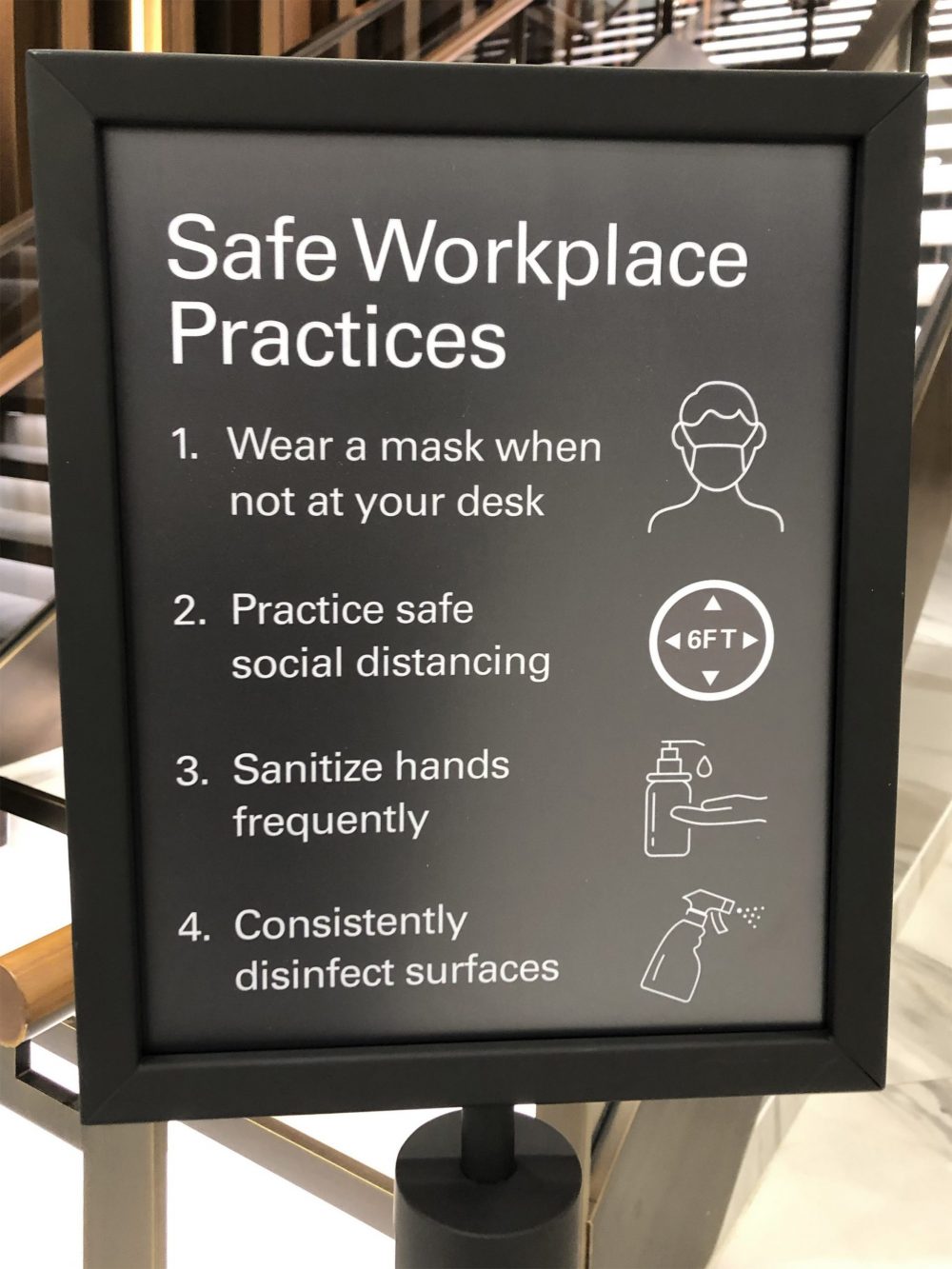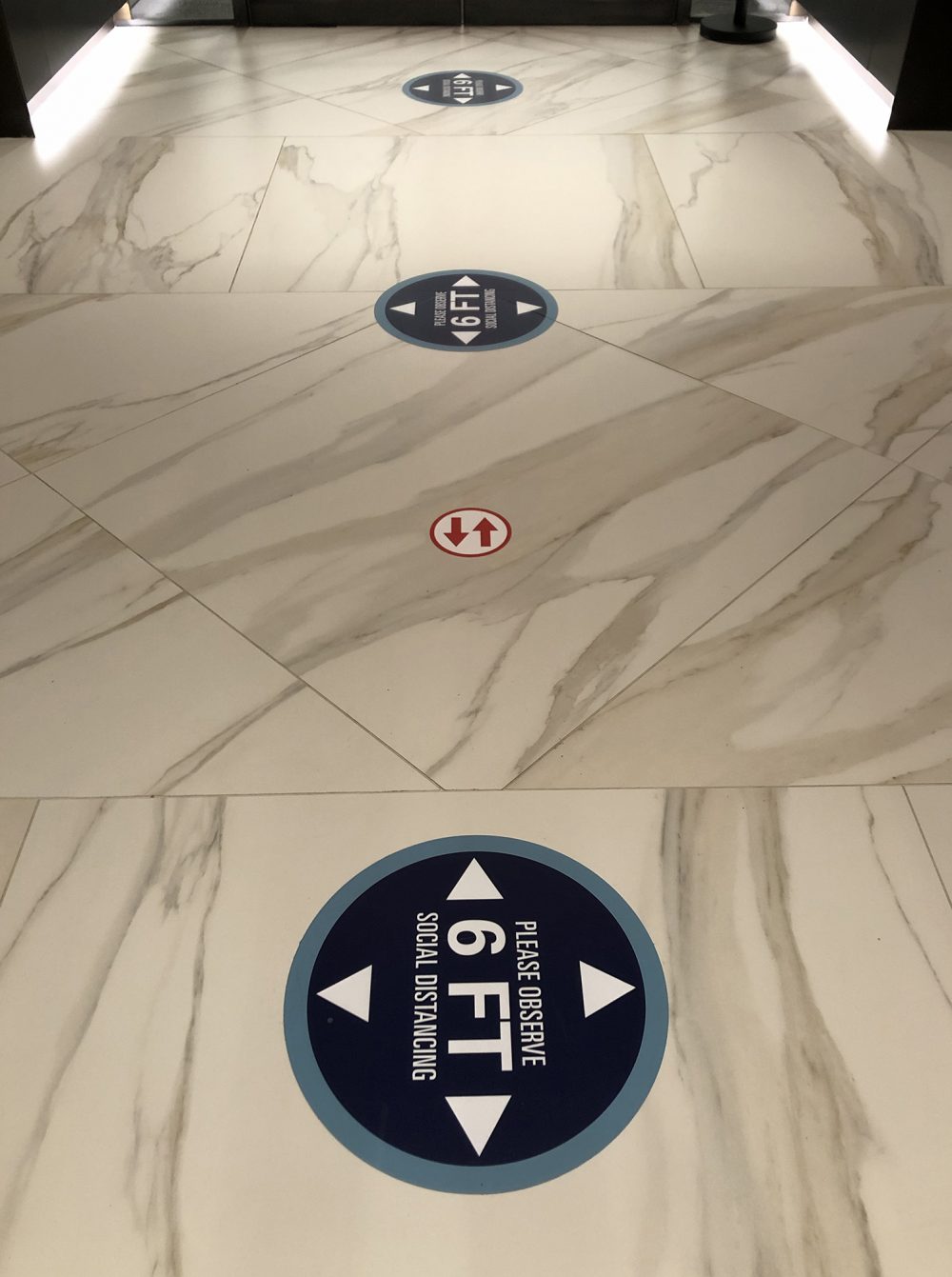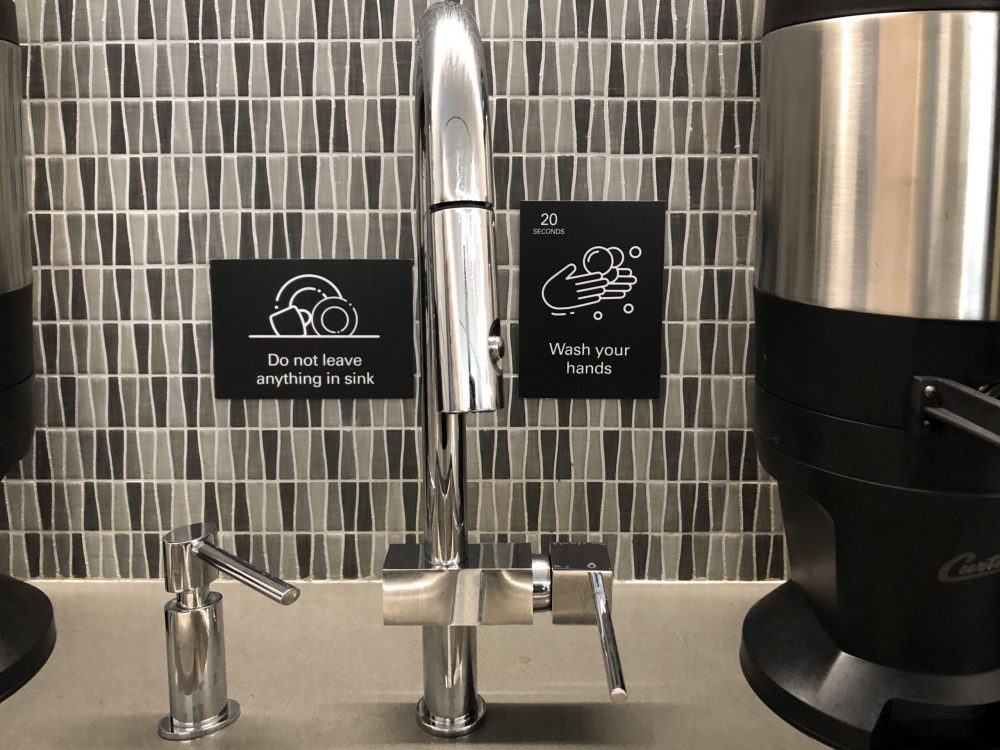As we return to the office, here’s how additional workplace wayfinding signs can help to remind employees of new safety measures.

As cities begin to reopen post-COVID-19 shutdown, employers are making plans for the phased reintegration of employees to their offices. If there’s one major takeaway from this event, it is the realization that the contemporary office, designed for collaboration, flexibility, creativity, and in many cases a “wow” factor, are not aligned with the new reality we now live in. It is certain, at least for the near future, office design will evolve to accommodate safety and comfortability. As a result, design firms are being engaged by companies to support their return to work efforts through seating strategies, signage, and workplace wayfinding intended to support safe and healthy office behaviors. These additional signs are meant to remind employees of emotional health support resources, supply reassurances around safety measures, and generally welcome employees back. These communications tend to fall within three main categories: Social Distancing, Office Flow, and Hygiene.

Keeping Your Distance, While Remaining Connected
Social distancing has proven to be one of the most effective deterrents to the spread of the coronavirus, but maintaining this within offices presents its fair share of challenges. To properly social distance in the workplace, companies need to reexamine the proximity of their employees to one another. As a result, floor plan analyses and reseating plans are needed, which are generally based on the six-foot radius recommended by the CDC. However, there are some companies that are taking it further by asking for plans that include up to 10 feet of radial distancing between seated employees. The result of any of these plans is a net capacity reduction typically in the 30-50 percent range. This raises an array of additional challenges for employers as they’re forced to make choices based on who is deemed essential, and then develop a criterion around that.

Within the office itself, beyond the reduced desk occupancy, social distancing is being reinforced across floors in several ways. We’ve all seen the various forms by which six-foot distancing is being expressed in public, for instance at the supermarket, or at other essential operations. Along these lines, design firms are developing floor markers to indicate proper social distancing. Some even come in multiple sizes, larger ones for exterior spaces like lobbies and reception areas, and smaller ones for interior spaces. These smaller types are generally placed within pantries, outside of restrooms, and around shared spaces where the need to wait can arise. They are made of vinyl and employ an adhesive appropriate for either non-porous flooring or carpet depending on the intended placement. In addition to the floor markers, general social distancing is being reinforced on signage, as well. Standing banners, stanchion signs, and wall-mounted solutions with a variety of messaging related to safe office practices are all good practice. These typically include reminders to observe six-foot distancing and are placed at entrances, within elevator lobbies, and throughout office spaces. These signage plans can be accompanied by detailed floor plans for location, elevations for installation, and upon request, 3D renderings for internal communications.

Finding Your (Office) Flow
Getting around the office comes with some new behaviors as well. Just getting from your desk to the pantry, the printer, or your supervisor’s desk comes with new concerns. To minimize the cross-flow of people, companies can implement workplace wayfinding strategies to optimize one-way traffic patterns within the various corridors and aisles of the office floor. Once these have been mapped and approved, floor marker arrows are installed to indicate preferred travel patterns. Additionally, companies can mark “hotspot” areas where one-way traffic is simply not possible, with unique floor markers. These are warnings to make people aware that they may encounter another individual and should be cautious, typical around bathrooms, pantries, and entrances. The truth is, some of this is simply unavoidable, as many offices do have corridors and aisles that have to accommodate two-way traffic. Admittedly this is also difficult to enforce. Oftentimes, people take the path of least resistance when it comes to coffee and bio-breaks, but it’s important to make the effort and with some peer reinforcement and behavioral adjustment these new patterns of movement can be another effective step to improving the safety of the office space.

Health and Hygiene
Aside from distancing and office flow, hygiene is the other major player in curbing the transmission of COVID-19 (as well as any virus). There’s a variety of signage around this which includes hand wash, use of masks, disinfecting shared spaces, and other reminders. Employers are also requiring masks within the office with the exception of when at your desk. Masks are worn primarily for the safety of others, and we’re seeing it’s generally accepted at this point that when at your desk you are distanced enough to be a non-threat without one. As a result, reminders to put one on when away from your desk have become necessary. To further mitigate health risks, shared technology, elevator buttons, and general cleanliness are all being reinforced at key points of contact, as well.
Perhaps an area that encompasses hygiene, office flow, and social distancing all in one is the restroom. A more complex area, the restroom seems to be a hot topic when it comes to workplace wayfinding. The challenges of social distancing in these areas are plentiful for obvious reasons. Limiting the availability of fixtures is one way to achieve appropriate distancing. This means taking some stalls, urinals, and sinks offline. Retaining the ADA compliant fixtures is essential and from there, it’s a pattern of every other when possible. To communicate this, signage solutions can be developed indicating fixtures not in use, which are intended for temporary door, backsplash, and wall mount installation. Human behavior will largely determine the success of these efforts, but the attempt is being made. Additionally, posted messaging about entering, use of, and exiting these areas are needed. It’s seen as important that people don’t line up within the bathrooms, and as a result, signage is developed to explain what to do when there’s no availability.

Driving Connections and Building Community
Many times, companies ask designers to interpret their brand’s identity through spatial and experiential design solutions. Office spaces are a physical embodiment of a brand’s essence, and this has been growing in importance over the last several decades as employee expectations for meaningful workspace has increased. What we’ve found, however, when it comes to the type of signage needed in relation to COVID-19 return to office efforts, is that these are not brand opportunities. While there are some instances where brand colors make sense, as well as some limited instances of logo use, these are generally not creative endeavors. It’s typical for companies to want complimentary aesthetics, but also a clear delineation between permanent signage and these temporary measures.
It’s important for these messages to stand out and carry a certain level of urgency without being overwhelming or alarming. Finding a balance between firm communication, helpful reminders, and comforting reassurances is the ultimate goal. Workplace wayfinding goes beyond the need for brand identity – it’s about people and how they connect with one another in a space that is governed by new rules. It’s admittedly a tricky balance to strike, but as this evolving situation requires ongoing assessment and flexible strategies, we expect the end result to be effective and helpful.

